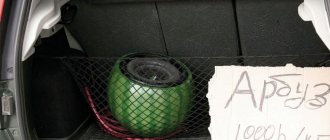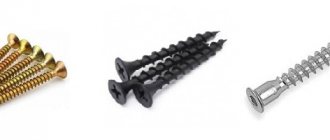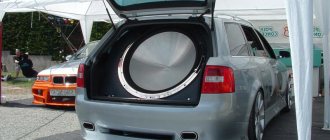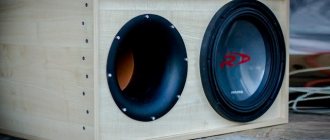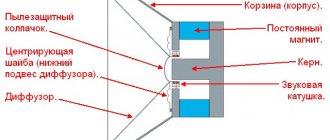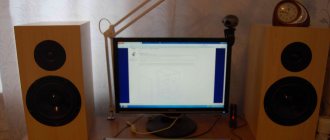A low-frequency speaker system is designed to reproduce a certain portion of the sound range. This area is located closer to the lower boundaries of the audibility zone and ranges from 20 to 100-200 Hz. The bass speaker is a durable box containing one or two powerful speakers. Due to the peculiarities of reproducing low frequencies, the diffusers have a large diameter, and the suspension provides a strong swing amplitude of the voice coil and diffuser. To prevent excess frequencies from reaching the subwoofer coil, a passive or active crossover filter is installed at the system input. You can buy a filter for a subwoofer or make it yourself.
DIY low-pass filter for a subwoofer
A low-pass filter for a subwoofer is a simple circuit that you can make yourself. This device, in its simplest form, contains an inductor and a capacitor, which is why the design is called an LC filter. Inductances and capacitances are reactive elements, therefore they change their resistance depending on the frequency of the signal. A capacitor changes its resistance in inverse proportion to frequency. When the capacitor is turned on in parallel with the load, the high-frequency component of the signal is short-circuited to ground, and low frequencies will pass unhindered to the speaker. The frequency at which signal suppression begins is called the cutoff frequency.
The ideal low-pass filter for a subwoofer should instantly “dampen” certain frequencies. This is shown in the picture with a yellow line. The real filter circuit for a subwoofer differs in that the roll-off occurs smoothly. The simplest device of two elements is called a first-order filter. It provides suppression of frequencies above the cutoff threshold of 6 dB per octave. A second-order circuit with additional elements increases the slope of the suppression to 12 dB per octave, and each subsequent link adds 6 dB. The more links, the stronger the suppression of the extra band of the audio range.
A filter circuit for a self-made subwoofer can include any number of links. The device can be passive or active.
JBL Basspro SL
Price: 10,500 rubles.
The loud installation from JBL falls slightly short of the top five. The universal design is equipped with a 200 mm emitter, complemented by a good amplifier, which altogether makes it possible to compete with other compact devices. However, this sub is significantly inferior to full-size designs in sound quality.
The main purpose of the unit is to provide sound to the general background. The model is capable of producing pleasant bass without squeaks and monotonous rumble, which is not bad.
Users consider excellent versatility to be the second positive point. There are all the necessary outputs and ports on board, which allows you to fine-tune the device. There is also a high-level connector that allows you to connect the subwoofer to a standard tape recorder.
Advantages:
- economical amplifier;
- good emitter;
- compact design.
Flaws:
extremely inconvenient pin placement.
Passive low pass filter for subwoofer circuit
You can make a passive low-pass filter for a subwoofer with your own hands in a short time. The circuit does not contain scarce parts and, when assembled correctly, does not require configuration. A simple low-pass filter for a subwoofer consists of only two parts. These are an inductor and a capacitor. In order to determine the electrical values of these elements, it is best to use an online calculator. To do this, type in the search bar “Calculation of LC filters. Online calculator." Next in the window you need to find the following table.
Here you just need to specify the desired cutoff frequency, load resistance and click “Calculate”. For example, with a speaker resistance of 4 ohms and a cutoff frequency of 220 Hz, the calculator will give a capacitance of the capacitor of 255.7 microfarads and an inductance of 4.09 millihenry. With a head resistance of 8 ohms and suppression of the “highs” starting from 250 Hz, the data will be 112.5 uF and 7.2 mH. You can make a low-pass filter for a subwoofer on a simple printed circuit board or use a PCB plate with contact pads.
The capacitance closest in value is used as capacitors. In the frequency filter for the subwoofer, you can use electrolytic capacitors, but it is better to use paper ones like “MBGO”, K73-16, or polypropylene capacitors K78-34 specially designed for speaker systems. To obtain the desired rating, capacitors can be connected in parallel. Inductors can be purchased ready-made or wound yourself.
Type of box (acoustic design)
The next thing we can visually determine how a subwoofer will play is to look at its box. The most common boxes that you can find in the store:
- Closed box (CL);
- bass inverter (FI);
- Bandpass (BP)
- Let's consider the advantages of a closed box. It has the most compact size, fast and clear bass, and minimal sound delays. Of the minuses - the quietest design. Now let's discuss the installation of a subwoofer in various car bodies. If you are the owner of a station wagon or hatchback, you can install 10, 12, 15 inches without any difference. If you have a sedan, it is not recommended to install the 10-inch in a closed box, you will simply hear it. The efficiency of the box is very low, 10 plays quietly, and in total nothing interesting will happen.
- The next option, which is often found, is a bass reflex. This is a box that has a slot or hole. It plays 2 times louder than a closed box and has dimensions an order of magnitude larger. However, in reality the sound quality is no longer as clear, it is more buzzy. Nevertheless, this is the best option and is suitable for absolutely any car body. Thus, the bass reflex is loud, its delays are within normal limits, a kind of golden mean. If you want to better understand this topic, we have an excellent article on how the box affects the sound of a subwoofer.
- Bandpass is a design in which the speaker is hidden in a box. Usually it is decorated with some beautiful plexiglass. It is the same size as a bass reflex, but has the greatest output. If you need to get the most out of the speaker, then it is better to purchase a bandpass. However, it also has its disadvantages, namely ─ the slowest design. It is difficult for this speaker to play fast club music, it will lag.
Do-it-yourself active filter for a subwoofer
Compared to passive designs, active circuits level out the amplitude-frequency response of a low-frequency signal, correcting peaks and valleys that negatively affect music listening. You can make a simple filter for a subwoofer with your own hands using a low-noise operational amplifier.
A low-pass filter circuit for a DIY subwoofer consists of two operational amplifiers and a small number of discrete elements. The main element is the LM324 integrated circuit, which contains four single-supply operational amplifiers, which is especially convenient if the subwoofer will be used in a car. The active device provides suppression of the high-frequency part of the audio range, starting from 120 Hz. There are many circuits of varying levels of complexity that are made using microcircuits or transistors. Integrated circuits require fewer parts and are not critical to changes in supply voltage.
A higher-quality circuit can be made using a specialized RT2351 microcircuit. Signals from the outputs of the stereo amplifier are fed to the input stages, mixed and sent to the active low-frequency suppression unit. The starting point for suppression of the high-frequency part of the spectrum is determined by the size of capacitors C3 and C7. The buffer stage allows you to connect the device directly to the speaker system.
The signal from two channels of a stereo amplifier through RC chains is supplied to the corresponding inputs of the integrated circuit. Thanks to the stabilizer, the microcircuit can be powered from any unipolar DC source with voltage up to 20 volts. The cutoff threshold of the active device is approximately 70 Hz. For some speaker systems, this attenuation value may be too low. For a suppression value of 200 Hz, the capacitor values should be as follows:
- C1 – 0.47 µF
- C2 – 0.47 µF
- C3 – 0.047 µF
- C7 – 0.068 uF
An active block for limiting the high-frequency part of the audio range can be used both for a home audio system and in a car. The disadvantage of this scheme can be considered the lack of smooth adjustment of the bandwidth, but this is not so important for the operation of the sound complex.
Purpose
The device in question is designed to make sound better; it is often called a crossover.
The purpose is to increase the efficiency of reproducing the required frequency.
Therefore, low-quality speakers can sound much better.
Various low-pass filters for the subwoofer are installed to achieve good sound quality from the audio system. Therefore, there is a need to select the most suitable product. If there is no suitable crossover for the subwoofer on sale, then you can make it yourself. The speakers of a car audio system can also be equipped with an adder.
Speakers installed in a cabinet in the form of a closed box
Despite their primitive design, subwoofers in closed boxes have many important advantages. The main thing is that such speakers are less susceptible to mechanical damage and still provide high-quality, clear sound. And their only drawback lies in their low efficiency, and the smaller the box, the lower its efficiency. But if you are looking for a reliable subwoofer that will serve you faithfully for many years, a model in a closed box is exactly what you need. 1
Pioneer TS-WX210A
10,700 rub. top best
️On the road with music: rating of the best 16 cm car speakers for 2022
Best selling sub in 2022. You can place the Japanese Pioneer almost anywhere: in the trunk, under the seat, and even in the cabin. And all because the model turned out to be not only powerful, but also compact. At the same time, the subwoofer is thought out to the smallest detail. It has high sensitivity, a wide range of supported frequencies and a robust housing that can withstand shaking and vibration. True, you shouldn’t count on all-consuming volume and power here: the maximum that a modest Japanese can do is 150 W. But in return, the model will delight you with stability, clear sound and reference quality.
10 /10
rating
pros
- Sensitivity 101 dB
- Neoprene diffuser
- Easy to install
- Clear sound
- Compact size
- Versatility
Minuses
Mediocre power
Pioneer TS-WX210A
2
JBL Basspro SL
11,000 rub. An unusual portable model in a compact body. JBL Basspro SL is best placed under the seat - this way it will sound much brighter, and installation will not take much time. Of course, you shouldn’t count on impressive acoustic pressure with it, but the subwoofer will perfectly complement your standard acoustics with clear, deep bass. According to car owners, the JBL Basspro SL honestly earns every ruble invested in it, and therefore even many hours of tuning does not deter avid music lovers at all. In addition, the sub is of standard quality and, if handled carefully, will last for many years.
9.5 /10
rating
pros
- Clear deep sound
- Economical energy consumption
- Easy to install
- Compact dimensions
- Unique design
- Optimal power reserve
Minuses
- Expensive
- Difficult to set up
JBL Basspro SL
3
Kicx ICQ 301BXA
7,300 rub. review
Rating of the best car polishes in 2022
Stylish car subwoofer in a closed box. Visually, the new Kicx ICQ 301BXA is not much different from its predecessor: the same body, a large 12-inch speaker and a purely symbolic grill, which does not protect the diffuser very well. But inside the changes are obvious: sensitivity has been increased to 90 dB, the volume of the box itself has expanded and bass has increased. But the parameters of the amplifier remained unchanged: still the same 120 W, which the subwoofer handles quite honestly. The model cannot boast of anything special, but the budget device more than justifies its price.
8.9 /10
rating
pros
- Compact dimensions
- Surround clear sound
- Bass depth
- Looks stylish
- Sensitivity 90 dB
- Optimal power
- Large speaker
- No noise
- Loyal price
Minuses
- Poor cooling system
- Lack of speaker protection
Kicx ICQ 301BXA
Homemade crossovers
It happens that having become the owner of an expensive car acoustics, the owner discovers that the kit does not include crossovers. It is clear that it will be impossible to do without them, since the HF speakers can simply burn out. What to do? The answer is ridiculously simple - make them yourself.
Tools
First, let's arm ourselves with the necessary tools:
- A good and convenient soldering iron.
- A special device that measures inductance.
- Glue "Moment".
- Ferric chloride.
- Foil fiberglass laminate.
- Heat shrink tube.
- Silicone sealant.
Step-by-step instruction
We begin the manufacturing process.
Crossover circuit
- First of all, you need to carefully study the technical characteristics of the purchased speakers. It is recommended to pay special attention to the low frequencies of the tweeters, as well as the level of characteristic sensitivity of the LF and HF speakers.
- Then you need to select the correct electrical circuit, which involves connecting a crossover.
Kicx ICQ-250BA
Price: 6500 rubles.
Completing the rating of good active subwoofers for cars is a device that feels great in large cars. A cheap case-type device is quite weighty and will not fit into every trunk, which limits its scope of application.
The power plant of the model does not show ultra-low frequencies, but the base amplifier is equipped with HF and LF type terminals, which allows it to be successfully used for listening to rock songs.
Additionally, the developers put a lot of effort into developing the software.
A complete set of tattoos requires skillful handling; without sufficient experience, it is difficult to set up the installation correctly.
Advantages:
- active filters;
- assembly;
- simple interface.
Flaws:
- controversial design;
- huge body.
